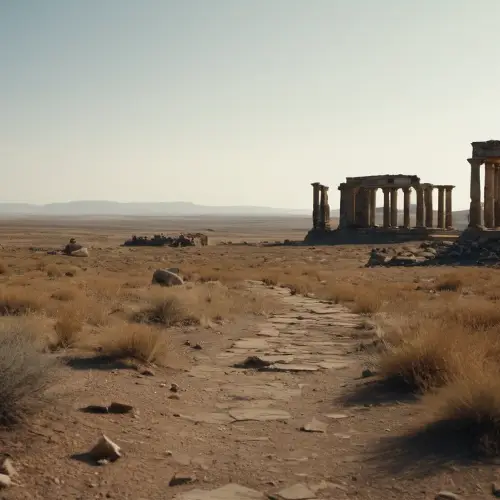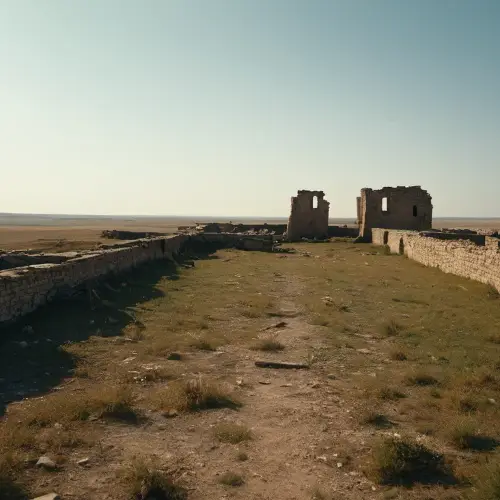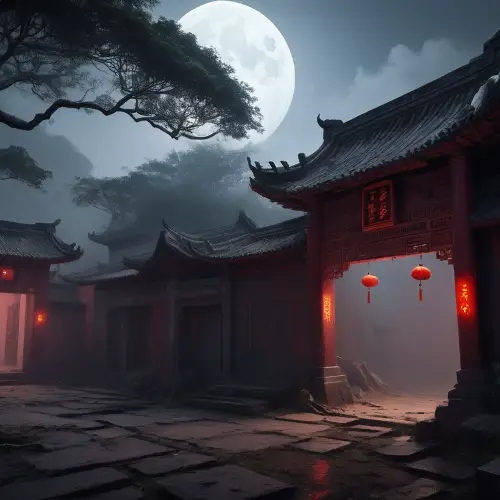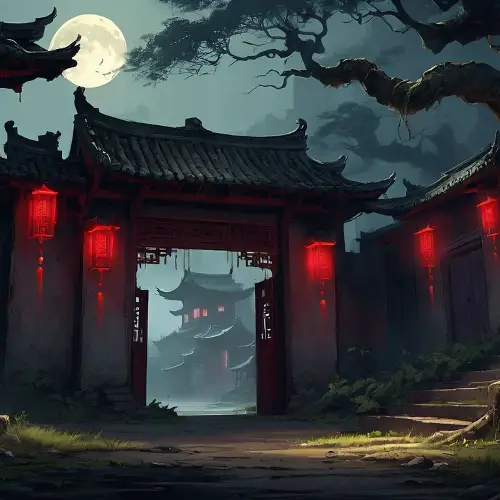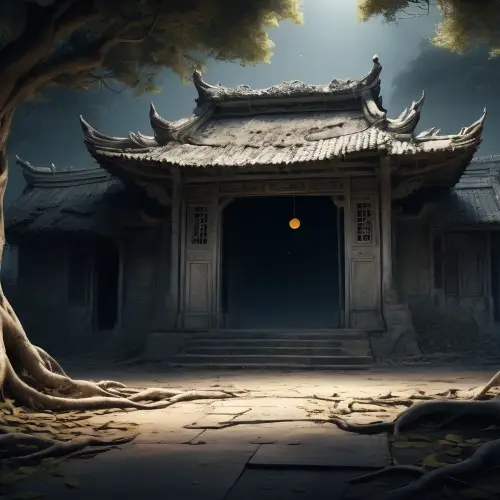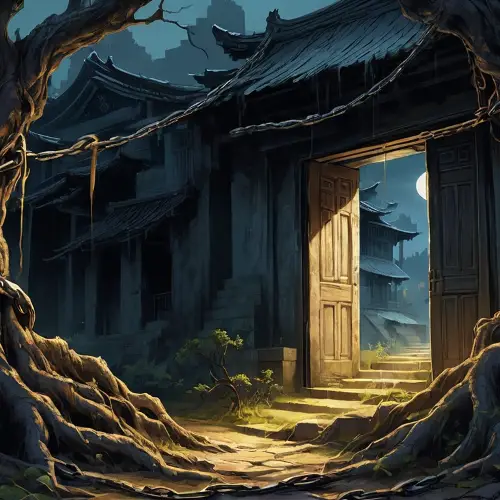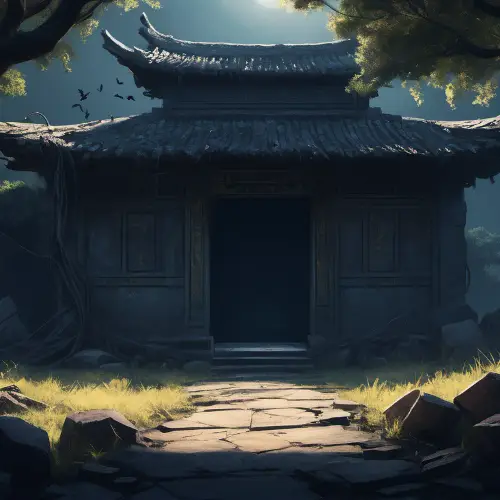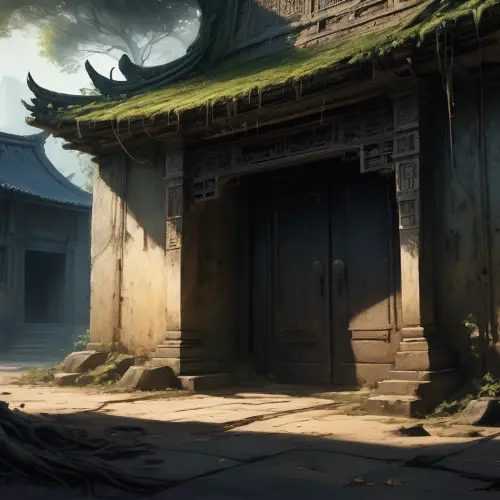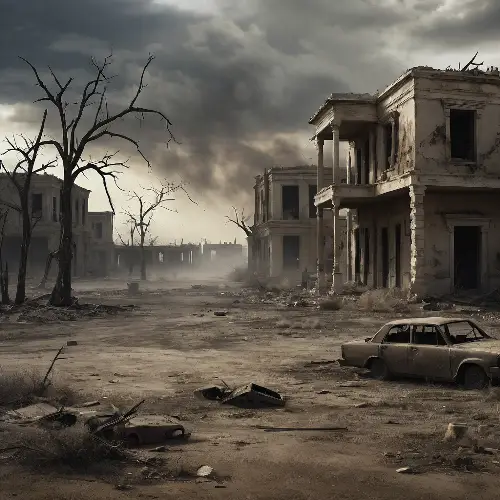In the heart of America's desolation, Eldridge stood as a testament to the secrets that lay dormant beneath the soil, waiting for a stranger like Jack to unearth them and, in doing so, reveal the haunting mysteries that bound the town to a fate as enigmatic as the vast and timeless landscape that cradled it.
More Like This
A vast and desolate landscape, endless ruins stretching to the horizon, an atmosphere of abandonment and mystery.
In the pitch-black night, amidst the fog-laden valleys of Hong Kong, an ancient desolate village looms in and out of sight. The structures of the village tilt and crumble, emitting an eerie and terrifying atmosphere. Graffiti remnants on the walls and weathered windows seem to recount ancient legends and mysterious tales. The dense fog pervades, further enhancing the village's air of mystery and eeriness.
The image shows a stairwell with a bearded man middle aged standing at the top. The stairs are in a state of disrepair, with significant wear and what appears to be rust or decay on the edges of the steps. The handrails on either side are also rusted and give the impression of long-term neglect. The walls of the stairwell are grimy and stained with dark marks that could be mold, soot, or simply the result of age and abandonment. The lighting is dim, coming from above and casting shadows that add to the eerie atmosphere of the setting. The person at the top of the stairs is facing the camera but their features are not clear due to the lighting. They are wearing casual attire and seem to be standing still. The person adds a human element to the otherwise desolate and deteriorating environment, which could invoke a feeling of tension or suspense for the viewer.
Beneath the encasing of the ashes, the landscape glowed in the darkest red as a lone Scavenger, Adventurer, Loner, Explorer, a hellion in the vast desolation, ventured forth to meet his maker. by Pebble Tay
Beneath the encasing of the ashes, the landscape glowed in the darkest red as a lone Scavenger, Adventurer, Loner, Explorer, a hellion in the vast desolation, ventured forth to meet his maker. by Pebble Tay
Beneath the encasing of the ashes, the landscape glowed in the darkest red as a lone Scavenger, Adventurer, Loner, Explorer, a hellion in the vast desolation, ventured forth to meet his maker. by Pebble Tay
Beneath the encasing of the ashes, the landscape glowed in the darkest red as a lone Scavenger, Adventurer, Loner, Explorer, a hellion in the vast desolation, ventured forth to meet his maker. by Pebble Tay
Beneath the encasing of the ashes, the landscape glowed in the darkest red as a lone Scavenger, Adventurer, Loner, Explorer, a hellion in the vast desolation, ventured forth to meet his maker. by Pebble Tay
Create a haunting 3D cartoon scene in a desert under a dark, cloudy sky. Illuminate the barren land with lightning and thunderbolts, revealing dry, cracked terrain scattered with bones and skulls. Perch an owl on a leafless tree branch, its silhouette adding an eerie presence. Use evocative graphics to bring this desolate, mysterious landscape to life, telling a visually striking tale of nature's power and the haunting beauty within the emptiness
The image shows a stairwell with a bearded 25 years man standing at the top. The stairs are in a state of disrepair, with significant wear and what appears to be rust or decay on the edges of the steps. The handrails on either side are also rusted and give the impression of long-term neglect. The walls of the stairwell are grimy and stained with dark marks that could be mold, soot, or simply the result of age and abandonment. The lighting is dim, coming from above and casting shadows that add to the eerie atmosphere of the setting. The person at the top of the stairs is facing the camera but their features are not clear due to the lighting. They are wearing casual attire and seem to be standing still. The person adds a human element to the otherwise desolate and deteriorating environment, which could invoke a feeling of tension or suspense for the viewer.
In Jeff VanderMeer's \"Annihilation,\" the first book of the Southern Reach Trilogy, the structure commonly referred to as the \"tunnel\" by the narrator is actually what might traditionally be considered a tower. However, the expedition team perceives and refers to it as a tunnel because it extends deep into the ground rather than rising above it.The tunnel is a central and enigmatic feature in Area X, a mysterious and uncharted territory where the novel is set. It is described as a circular shaft that burrows deep into the earth, with a spiral staircase winding down along its walls. The walls of the tunnel are covered in a strange, living writing or script, which glows with a faint, otherworldly light. This script is later revealed to be a form of life or a manifestation of the bizarre ecosystem of Area X.The interior of the tunnel is damp and has an organic quality, almost as if it is a living entity itself. The atmosphere inside is oppressive and disorienting, contributing to the sense of unease and foreboding that permeates the novel. As the characters descend, they encounter increasingly strange phenomena and biological oddities, which challenge their understanding of the natural world and their own perceptions.The tunnel, with its mysterious script and alien environment, symbolizes the unknown and the unknowable aspects of nature and reality as portrayed in Area X. It becomes a site of transformation and revelation for the characters, particularly the biologist, the narrator of the book, who is drawn to its mysteries and the secrets it holds about the true nature of Area X.
In Jeff VanderMeer's \"Annihilation,\" the first book of the Southern Reach Trilogy, the structure commonly referred to as the \"tunnel\" by the narrator is actually what might traditionally be considered a tower. However, the expedition team perceives and refers to it as a tunnel because it extends deep into the ground rather than rising above it.The tunnel is a central and enigmatic feature in Area X, a mysterious and uncharted territory where the novel is set. It is described as a circular shaft that burrows deep into the earth, with a spiral staircase winding down along its walls. The walls of the tunnel are covered in a strange, living writing or script, which glows with a faint, otherworldly light. This script is later revealed to be a form of life or a manifestation of the bizarre ecosystem of Area X.The interior of the tunnel is damp and has an organic quality, almost as if it is a living entity itself. The atmosphere inside is oppressive and disorienting, contributing to the sense of unease and foreboding that permeates the novel. As the characters descend, they encounter increasingly strange phenomena and biological oddities, which challenge their understanding of the natural world and their own perceptions.The tunnel, with its mysterious script and alien environment, symbolizes the unknown and the unknowable aspects of nature and reality as portrayed in Area X. It becomes a site of transformation and revelation for the characters, particularly the biologist, the narrator of the book, who is drawn to its mysteries and the secrets it holds about the true nature of Area X.
In Jeff VanderMeer's \"Annihilation,\" the first book of the Southern Reach Trilogy, the structure commonly referred to as the \"tunnel\" by the narrator is actually what might traditionally be considered a tower. However, the expedition team perceives and refers to it as a tunnel because it extends deep into the ground rather than rising above it.The tunnel is a central and enigmatic feature in Area X, a mysterious and uncharted territory where the novel is set. It is described as a circular shaft that burrows deep into the earth, with a spiral staircase winding down along its walls. The walls of the tunnel are covered in a strange, living writing or script, which glows with a faint, otherworldly light. This script is later revealed to be a form of life or a manifestation of the bizarre ecosystem of Area X.The interior of the tunnel is damp and has an organic quality, almost as if it is a living entity itself. The atmosphere inside is oppressive and disorienting, contributing to the sense of unease and foreboding that permeates the novel. As the characters descend, they encounter increasingly strange phenomena and biological oddities, which challenge their understanding of the natural world and their own perceptions.The tunnel, with its mysterious script and alien environment, symbolizes the unknown and the unknowable aspects of nature and reality as portrayed in Area X. It becomes a site of transformation and revelation for the characters, particularly the biologist, the narrator of the book, who is drawn to its mysteries and the secrets it holds about the true nature of Area X.
In a landscape of unobstructed emptiness, a Scavenger, Adventurer, Loner, Explorer confronts a crisis of revelation, discovering that the magic he sought was the same force that rendered the vast expanse a canvas of profound solitude. by Albert Bierstadt
In a landscape of unobstructed emptiness, a Scavenger, Adventurer, Loner, Explorer confronts a crisis of revelation, discovering that the magic he sought was the same force that rendered the vast expanse a canvas of profound solitude. by Albert Bierstadt
Inky night smothers the valley, not a glimmer piercing veils shrouding aeons past. From shifting mists emerge pale figures wreathed in sorrow — kings laid to rest yet longing to warn of final secrets this place keeps. Wraithlike they drift ’twixt massive monoliths holding fast the world before man learned his reign must end. One phantom’s haggard mien holds counsels none now living could endure, of kingdom crushed to dust, name lost to the desert’s claim. Another’s hollow eyes retain but fading echoes of divine command, a boy made vessel for gods now crumbled into the earth. And towering silent guard, immutable, the pyramids absorb the mysteries even restless spirits leave untouched. In shrouds of mist the forlorn kings float amid ruins of glory that shook celestial halls — a civilization’s legacy kept here while the very stars alter their course, and the circlings of the sun work changes none may discern ‘til dawn unveils what night held close.
a vast landscape of chalky and cavernous mesas with different layers of stone and gigantic holes in the ground
Compose a cinematic 3D cartoon scene, unfolding in a vast desert landscape with a radiant sun and crystal-clear sky. Capture the distant charm of a small town, its silhouette barely visible on the horizon. Artfully render the town's details against the backdrop of charmingly ruined homes and walls. Utilize vibrant graphics to seamlessly blend whimsy with desolation, narrating a visually stunning tale that emphasizes the town's resilience in this unique and expansive setting
an ancient temple overgrown with vegetation in a dense jungle setting. The temple's architecture suggests Southeast Asian influences, possibly reminiscent of the Angkor Wat style in Cambodia. The structure is intricately carved, with a prominent doorway that stands as a darkened entry point, inviting yet mysterious. The stone of the temple is weathered and covered in moss, indicating that it has been reclaimed by the forest over many years. The vegetation is lush, with large ferns and foliage draping over the temple, and vines hanging from the trees. The light filters through the dense canopy above, creating a natural spotlight effect on the temple, enhancing its mystical and forgotten appearance. This scene evokes a sense of discovery and could easily be a setting from an adventure tale, where ancient ruins hold secrets of the past. The overall atmosphere is serene and somewhat magical, capturing the quiet power of nature as it intertwines with human history.
an ancient temple overgrown with vegetation in a dense jungle setting. The temple's architecture suggests Southeast Asian influences, possibly reminiscent of the Angkor Wat style in Cambodia. The structure is intricately carved, with a prominent doorway that stands as a darkened entry point, inviting yet mysterious. The stone of the temple is weathered and covered in moss, indicating that it has been reclaimed by the forest over many years. The vegetation is lush, with large ferns and foliage draping over the temple, and vines hanging from the trees. The light filters through the dense canopy above, creating a natural spotlight effect on the temple, enhancing its mystical and forgotten appearance. This scene evokes a sense of discovery and could easily be a setting from an adventure tale, where ancient ruins hold secrets of the past. The overall atmosphere is serene and somewhat magical, capturing the quiet power of nature as it intertwines with human history.
On the shores of the forgotten sea, where the waters whisper secrets, ancient ruins loom. Their stones are worn by time and tide, yet they stand resilient, guardians of histories submerged beneath the waves, where every tide brings a tale, and every wave sings of bygone eras.
Under the dim yellow moonlight, an abandoned village stands tall in the desolate valley. Decaying wood crisscrosses the courtyard gate, seemingly emitting a mysterious aura. On the stone steps in front, dry and yellowed vegetation entwines, resembling the lament of countless lost souls. Around the houses, a profound forest looms, concealing countless indescribable mysteries in the darkness. Hanging on the house doors are ancient rusty chains, producing a faint jingling sound as if conveying some form of restraint. The lintels are inscribed with crimson Chinese characters, forming a string of mystical incantations. In front of these ancient village houses, a few wisps of ethereal mist drift, as if the gaze of ancestral spirits is upon them. At the center of the image, a colossal banyan tree stretches its branches, deeply rooted within the houses' crumbling walls. Faintly discernible faces appear among the tree roots, as if spirits possessed by the tree deity. Moonlight filters through the gaps in the leaves, creating a variegated play of light and shadow on the ground, akin to intertwining yin and yang symbols. The entire scene is shrouded in a profound, dark red hue, permeating a mysterious and oppressive atmosphere. It seems to connect reality and dreams, delineating a mysterious and terrifying setting that evokes a sinister force of traditional Chinese ghostly and supernatural tales.
Ancient, moss-covered stone giant, hunched over a glowing crystal ball cradled in its hands, gnarled roots weaving through cracked stone fingers, emerald moss cloaking weathered features, crystalline veins pulsing with ethereal light, forgotten temple ruins overgrown with jungle foliage, shafts of sunlight piercing dense canopy, mystical atmosphere, otherworldly glow, photorealistic, high resolution, intricate details, cinematic lighting, sense of ancient power, lost knowledge, forgotten secrets, nature reclaiming the sacred, timeless mystery
Beneath the surface of a city lies an ancient, forgotten library. Tall shelves carved into the rock are filled with dusty tomes and scrolls, containing lost knowledge and secrets. Dimly lit by candles, the library's atmosphere is one of mystery and discovery, inviting explorers to uncover its hidden truths.
A silent, eerie, and terrifying hillside is shrouded in dim moonlight. Scattered across the ground are numerous small mounds of soil.
Under the dim yellow moonlight, an abandoned village stands tall in the desolate valley. Decaying wood crisscrosses the doors of the houses, seemingly emitting a mysterious aura. On the stone steps in front, dry and yellowed vegetation entwines, resembling the lament of countless lost souls. Around the houses, a profound forest looms, concealing countless indescribable mysteries in the darkness. Hanging on the doors of the houses are ancient rusty chains, producing a faint jingling sound as if conveying some form of restraint. In the center of the image, a colossal banyan tree stretches its branches, deeply rooted within the crumbling walls of the houses. Moonlight filters through the gaps in the leaves, creating a variegated play of light and shadow on the ground, akin to intertwining yin and yang symbols. The entire scene seems to connect reality and dreams, delineating a mysterious and terrifying setting that evokes a sinister force of traditional Chinese ghostly and supernatural tales.
Under the dim yellow moonlight, an abandoned village stands tall in the desolate valley. Decaying wood crisscrosses the doors of the houses, seemingly emitting a mysterious aura. On the stone steps in front, dry and yellowed vegetation entwines, resembling the lament of countless lost souls. Around the houses, a profound forest looms, concealing countless indescribable mysteries in the darkness. Hanging on the doors of the houses are ancient rusty chains, producing a faint jingling sound as if conveying some form of restraint. In the center of the image, a colossal banyan tree stretches its branches, deeply rooted within the crumbling walls of the houses. Moonlight filters through the gaps in the leaves, creating a variegated play of light and shadow on the ground, akin to intertwining yin and yang symbols. The entire scene seems to connect reality and dreams, delineating a mysterious and terrifying setting that evokes a sinister force of traditional Chinese ghostly and supernatural tales.
dream prompt:The cover of the Lost City adopts a mysterious and enigmatic dark color palette. Through a veil of mysterious radiance, it outlines the silhouette of ancient ruins. Weathered and peculiar, the ancient architectural elements bear witness to the erosions of time, as if they are witnesses to history. Adventurers traverse the city ruins, witnessing the fragmentation and silence of ancient structures. Strange sculptures and symbols in the city hint at the mysterious power of the Lost City. The overlapping effects of time and space on the cover create a sensation of traversing through time, allowing viewers to sense the citys existence across multiple eras. The overall scene exudes an atmosphere of an unknown realm, leaving ample room for imagination and sparking the readers curiosity about the profound history of the Lost City.
dream prompt:The cover of the Lost City adopts a mysterious and enigmatic dark color palette. Through a veil of mysterious radiance, it outlines the silhouette of ancient ruins. Weathered and peculiar, the ancient architectural elements bear witness to the erosions of time, as if they are witnesses to history. Adventurers traverse the city ruins, witnessing the fragmentation and silence of ancient structures. Strange sculptures and symbols in the city hint at the mysterious power of the Lost City. The overlapping effects of time and space on the cover create a sensation of traversing through time, allowing viewers to sense the citys existence across multiple eras. The overall scene exudes an atmosphere of an unknown realm, leaving ample room for imagination and sparking the readers curiosity about the profound history of the Lost City.
As the apocalyptic scene fades away, the camera slowly pans out, leaving a profound impression on viewers. The landscape depicts desolation and ruin. Scattered amidst barren land are dilapidated structures, shrouded in smoke, while remaining trees stand lifeless and withered. The sky is veiled in thick dust, the sunlight struggling to penetrate through dense, ashen clouds. The wind carries only a desolate howl and swirling dust. Amidst this desolation, remnants of human existence stand out. Abandoned cars and scattered belongings litter the deserted streets, the sole remnants of life in this bleak panorama. Those who remain traverse the ruins silently, their attire worn and their steps feeble. Their weary eyes betray exhaustion and despair, yet cling to an indomitable will to survive. The entire scene exudes an overwhelming sense of suppressed despair, each detail recounting the past glory and current desolation. This imagery etches deeply into the mind, a poignant and awakening tableau, serving as a solemn reminder to cherish and protect our natural environment.
As the apocalyptic scene fades away, the camera slowly pans out, leaving a profound impression on viewers. The landscape depicts desolation and ruin. Scattered amidst barren land are dilapidated structures, shrouded in smoke, while remaining trees stand lifeless and withered. The sky is veiled in thick dust, the sunlight struggling to penetrate through dense, ashen clouds. The wind carries only a desolate howl and swirling dust. Amidst this desolation, remnants of human existence stand out. Abandoned cars and scattered belongings litter the deserted streets, the sole remnants of life in this bleak panorama. Those who remain traverse the ruins silently, their attire worn and their steps feeble. Their weary eyes betray exhaustion and despair, yet cling to an indomitable will to survive. The entire scene exudes an overwhelming sense of suppressed despair, each detail recounting the past glory and current desolation. This imagery etches deeply into the mind, a poignant and awakening tableau, serving as a solemn reminder to cherish and protect our natural environment.
In the heart of a forsaken city, a 100-foot stone pyramid stands in eerie solitude, absorbing the dying suns haunting glow. Surrounded by skeletal buildings and pillars, the desolate scene, a chiaroscuro masterpiece, whispers of forgotten tales etched in cryptic symbols. This oil-painted resonance freezes time, portraying a citys silent surrender to the enigma of the solitary pyramid.
Medieval village: rustic houses, cobblestone streets. Villagers astounded by a gleaming modern smartphone iPhone 15 Pro. Awe, confusion, curiosity evident on their faces. Ancient attire juxtaposed with futuristic device. Detailed, ultra-realistic scene emphasizing contrast: medieval simplicity meets advanced technology. Emotions range from wonder to suspicion. Surroundings rich in intricate details, weathered structures, and mesmerizing device glow. Scene evokes a sense of discovery, bridging centuries in a single moment
Under the dim yellow moonlight, an abandoned temple stands tall in the desolate valley. Decaying wood crisscrosses the temple gate, seemingly emitting a mysterious aura. On the stone steps in front, dry and yellowed vegetation entwines, resembling the lament of countless lost souls. Around the temple, a profound forest looms, concealing countless indescribable mysteries in the darkness. Hanging on the temple gate is an ancient rusty chain, producing a faint jingling sound as if conveying some form of restraint. The gate's lintel is inscribed with crimson Chinese characters, forming a string of mystical incantations. In front of this ancient temple, a few wisps of ethereal mist drift, as if the gaze of ancestral spirits is upon them. At the center of the cover, a colossal banyan tree stretches its branches, deeply rooted within the temple's crumbling walls. Faintly discernible faces appear among the tree roots, as if spirits possessed by the tree deity. Moonlight filters through the gaps in the leaves, creating a variegated play of light and shadow on the ground, akin to intertwining yin and yang symbols. The entire scene is shrouded in a profound, dark red hue, permeating a mysterious and oppressive atmosphere. Around the temple, a delicate mist wafts, seemingly connecting reality and dreams, delineating a mysterious and terrifying setting that evokes a sinister force of traditional Chinese ghostly and supernatural tales.
Its cobbled streets, cracked and overgrown with weeds, wind through the village, leading travelers past dilapidated houses and abandoned storefronts. A sense of eerie stillness pervades the air, punctuated only by the distant echoes of rustling leaves and the occasional creaking of decaying wooden structures. Broken remnants of a once-proud fountain in the town square stand as a melancholic testament to Conyberry's faded glory.
In the desolate heart of a mountain range, where jagged peaks pierce the sky and an unforgiving chill bites at the very air, stands a castle cloaked in an eerie silence. This fortress, isolated and haunting, is surrounded by an endless expanse of ice that stretches as far as the eye can see. The cold wind howls through the narrow valleys, carrying with it whispers of ancient secrets and forgotten tales. The castle itself is a looming structure of gray stone, its turrets and towers reaching for the heavens like skeletal fingers grasping at the fading light. The windows, cracked and frosted over, resemble vacant eyes that seem to watch the frozen landscape with a sense of foreboding. The massive gates, half-buried in snow, creak open reluctantly, revealing a passageway into the heart of the frozen fortress. As you traverse the shadowy corridors within, the air grows colder, and the echoes of your footsteps bounce off the cold, stone walls. Faint, ghostly murmurs seem to whisper through the chambers, and the occasional sound of distant, haunting laughter echoes through the emptiness. Venturing outside, a haunting forest of dead trees surrounds the castle. Their skeletal branches reach toward the sky like frozen claws, casting eerie shadows on the icy ground. The trees stand like silent sentinels, their twisted forms creating an otherworldly atmosphere. In the stillness of the night, the forest seems to come alive with spectral figures, their movements obscured by the fog that clings to the frozen ground. As you navigate this desolate landscape, a sense of dread intensifies. The combination of the icy fortress, the ghostly whispers, and the skeletal forest creates an atmosphere of terror, where the line between the living and the dead becomes blurred, and the past echoes through the frozen air, revealing the chilling secrets of the castle hidden among the mountains.


